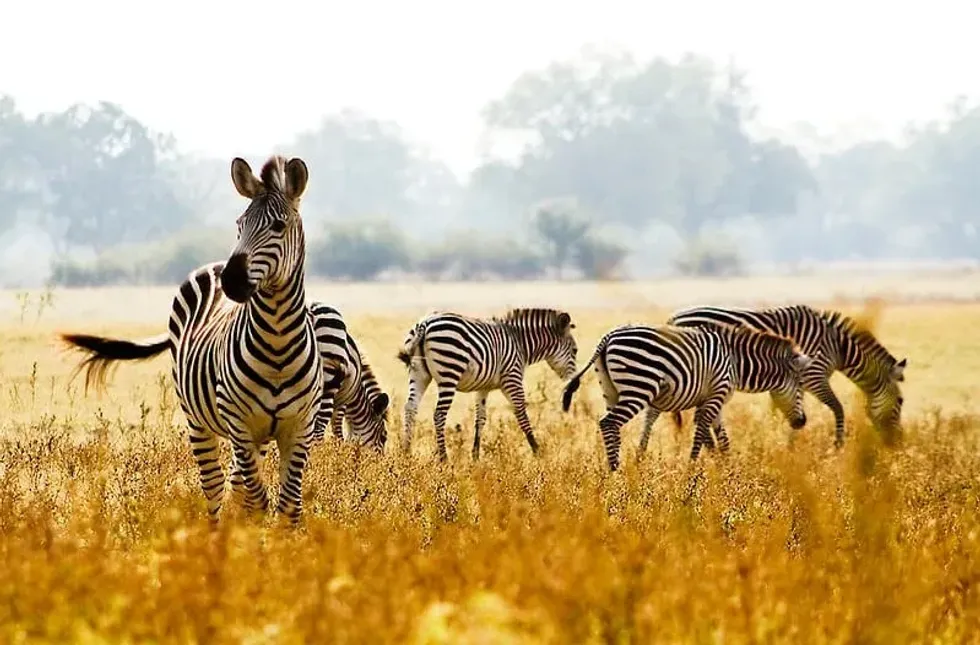The African Savanna/Savannah is home to some of the world's best-known wildlife.
Unlike in a forest, this grassland biome (community of plants and animals designed to live in a certain environment) has trees that are scattered around, which offers fewer hiding places for the animals that live there. Another characteristic of a savanna is that it has a dry season, which makes food and water scarce.
In Africa, the savanna is always warm but there is a rainy wet season, which is followed by five or more months of dry season.
Many of the savanna animals have adapted to this in different ways - some (large animals such as wildebeest and elephants and birds) migrate to another area to find water and food, while many animals, usually smaller ones, hibernate (rest in a safe place, their heartbeat lowers, and they reduce food and water needs to a minimum) until the rains return.
Savannas also exist in Australia, Asia, and South America. They all experience a rainy and dry season.
Camouflage patterns
In the African savanna, you will find grazing animals that feed on the grass and trees, such as zebras, gazelle and giraffes. To protect themselves from predators such as lions and hyenas, animals have undergone adaptations such as being camouflaged (this means to hide and disguise) so that they blend in with their surroundings and don't stand out.
Small animals in savanna biomes such as mice and meerkats use adaptations such as mimicry - this means they are the same sandy colour as their surroundings. Small animals also have the ability to protect themselves by burrowing into homes underground and being active at night time (this is called being nocturnal). They can also run very quickly!

Large animals in the savanna such as zebras and giraffes have a patterned fur, hair and skin, which breaks up their large outlines, making them harder to see. If you're wondering how a black and white animal like a zebra can hide in brown grasses, it has adapted in a very clever way.
The stripes mimic the wavy lines of the grasses, and because their natural predator, the lion, is colour blind, it doesn't matter that they are a very different colour - what a clever adaptation!
And because zebras are herd animals. lions find it hard to pick one animal to target, as they look like one huge stripy creature!
It's not only prey animals (those that get killed and eaten) that are camouflaged, Carnivores (meat eaters) such as lions and cheetahs also have to hide, so that they can creep up on their prey. Lions have a sandy-coloured coat that disappears in the savannah's long grasses.
One savanna animal, the cheetah, has a spotted coat that allows them to avoid being seen as well - they can also run quicker than any other creature on earth - up to 65mph. Another example of animal adaptations.

Camouflage experiments
Try these fun experiments, to discover for yourself how effective camouflage can be.
1. Do you have a predator's vision?
Can you spot the hidden paper, like a lion spots a zebra? Try this experiment out on friends and family and see who has the best predator vision.
You will need:
Two pages from a newspaper that has text only
Scissors
Pencil
Different coloured paper
Method
Lay a large page of newspaper out - this will be your background.
Next, cut five pieces of coloured paper, each measuring 2x4in (5x10cm).
Now cut out five pieces of newspaper, the same size as the coloured shapes. They must show text only.
Lay all the pieces randomly on the large sheet of newspaper.
Bring in your test subject! They must keep their eyes closed and then look at the newspaper for a second only. Get them to quickly turn around and tell you how many rectangles they saw.
You can repeat the test, allowing them to look at the paper for longer - how do the results change?
The science part
The pieces of newspaper are camouflaged animals, the coloured pieces are the animals without camouflage. See how much they stand out! If you imagine that the big piece of newspaper is a herd of zebras, and the smaller pieces individual animals, see how hard it is to pick one out!
No wonder Clarence the lion was cross-eyes! (Google it if you don't get the reference! ).
2. Hidden habitat
You will need:
A fish tank or terrarium
A toy snake, bug or lizard
Lots of materials to create a habitat - grass, twigs, leaves, fake foliage, stones etc.
Method:
Get your kids to design a habitat for a fish tank or terrarium. Let them build their habitat and then 'hide' the creature within it. See how easily you can spot it.

3. Sweet spots for hiding
You will need:
Green skittles/Yellow skittles
Green M&Ms/Yellow M&Ms
Method:
Layout the green Skittles together, next to the yellow Skittles so they simulate the grassland and the beach.
The M&Ms are going to represent little bugs and insects. Put the green M&Ms in the 'grassland' and the yellow M&Ms in the 'beach' area.
Now pretend you are a bird and see how easy (or not) it is to pick out the creatures while they are camouflaged.
Next, take away some of the grassland (imagine it has now been built on).
Now, some of your green creatures start to head out into the beach to find food, so move some of the green M&Ms into the yellow 'beach'.
Now, see how quickly you can pick out the M&Ms from the Skittles!
The science part
As well as showing how well camouflage can work to help prey animals hide from predators, it also highlights how wildlife can be threatened when its natural habitats are take away.

4. Camouflage patterns
You will need:
Stones
Acrylic or poster paint
Large sheets of paper
Some images of animal patterns to copy (giraffe, zebra, snakes etc)
Method:
Paint the sheets of paper with backgrounds to represent grassland, beaches, green jungle and so on.
Pain the stones with different animal patterns.
Experiment by placing the stones on the different background and seeing where they blend in the best.
The science part
Observe how different animals have adapted to remain camouflaged in their habitat. Discuss how their habitat changing through human intervention could threaten the food chain.












